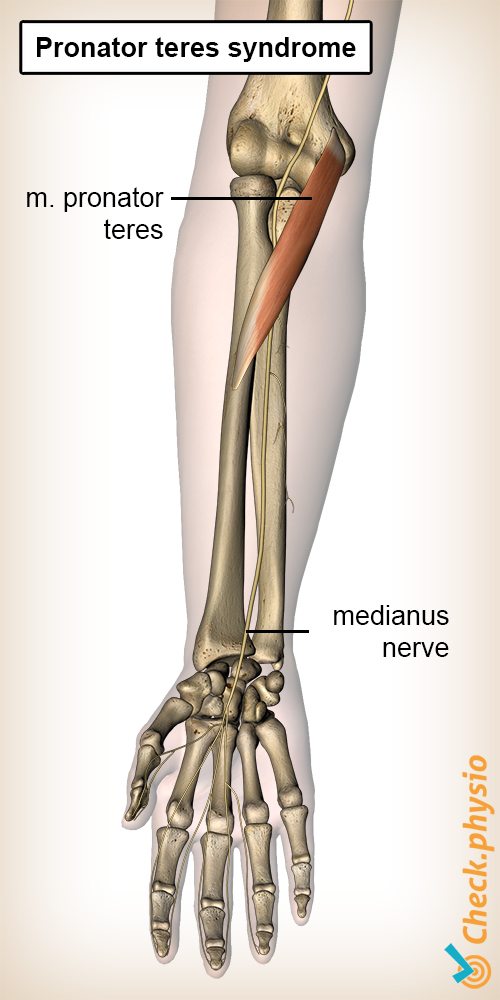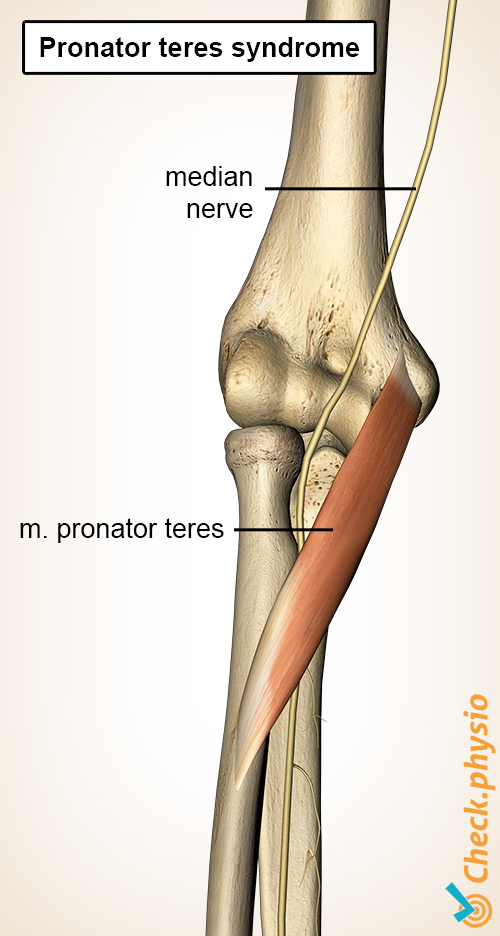- Conditions
- Pronator teres syndrome
Pronator teres syndrome
Introduction
Pronator teres syndrome is a condition where one of the nerves in the forearm becomes trapped. A specific forearm muscle plays an important role in this. The symptoms that occur with pronator teres syndrome are pain, loss of sensation and decreased strength in the hand.

Description of condition
The nerve in the forearm that becomes compressed in the pronator teres syndrome is called the median nerve. The pronator teres muscle plays an important role here. This is the muscle in the forearm that turns the palm inward.
When the muscles contract often and forcefully, they become larger and thicker. This is usually a positive effect of training. But in case of the pronator teres, it also causes problems. This is because the median nerve runs through or just past the pronator teres muscle. When this muscle is over-developed, it can compress the nerve.
As a result, symptoms start occurring in the area served by the nerve. People with the pronator teres syndrome, suffer from pain on the palm side of the forearm, and loss of sensation in the thumb, index finger, middle finger and ring finger. There is also often some reduction in strength in the thumb. The symptoms usually subside once the arm has not been used (vigorously) for a while.
Cause and history
Usually, pronator teres syndrome is the result of over-development of the pronator teres muscle in people who use it frequently, and forcefully. Screw-driving and sports such as golf and tennis are examples of this. The median nerve becomes irritated as a result. Connective tissue strands may also be present and cause obstruction at this location, or a direct blow to the forearm may cause irritation to the nerve.
Signs & symptoms
Typical symptoms of pronator teres syndrome are:
- Pain on the palm side of the forearm.
- Loss of sensation in forearm, thumb, index, middle and ring finger.
- Loss of strength in forearm and thumb.
- The symptoms diminish at rest.
- Activities where the palm of the hand is turned downward, e.g. typing and screw-driving, aggravate the symptoms.
Diagnosis
A physician or physiotherapist will inquire about the symptoms and how they occurred. This is followed by a physical examination. This involves looking at the strength of the muscles, and the sensation in the forearm and fingers. A test is also carried out to see whether the symptoms increase when the pronator teres tightens. When tapped slightly below the elbow, it stimulates the nerve and induces tingling.
If in doubt, an MRI scan or an electromyography (EMG) can be carried out. If an MRI, the physician is looking for the likely cause of the compression. An EMG measures the velocity at which a nerve transmits signals. When a nerve is compressed, the conduction velocity decreases.
Treatment and recovery
Taking rest will reduce the symptoms. Potentially with help from a splint, medication and (hand) physiotherapy. The (hand) physiotherapist will try to make the pronator teres relax in order to reduce the pressure on the nerve.
If, after a while (three to six months), there is still no, or insufficient, improvement then surgery may be an option. During this surgery, the surgeon frees the nerve, causing the symptoms to disappear. After surgery, the arm can soon be used again. It is important to follow the recommendations of the (hand) physiotherapist at this time.
Exercises
View the exercise program with exercises for pronator teres syndrome.
More info
You can check your symptoms using the online physiotherapy check or make an appointment with a physiotherapy practice in your locality.
References
Dididze, M., Tafti, D. & Sherman A.l. (2021) Pronator Teres Syndrome StatPearls Publishing LLC..

